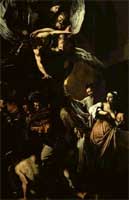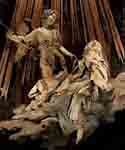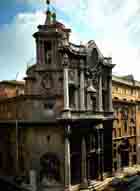The XVII century was the century of the Counter-Reformation and all over Europe many wars were fought in the name of religion and the previous power status changed. The effects of these wars were felt in art, which abandoned Mannerism at the end of the XVI century. The word ‘baroque’ was applied to XVII century art from the beginning of the XVIII century. It had a negative meaning because it referred to exaggerated and bizarre art. Only in modern times has this negative meaning been removed.
The art of this period, born as an answer to Protestantism, became extremely important for the spreading, throughout the general population, of counter reformation ideas and it was used to bring the general population back to Catholicism. Baroque art was supposed to touch the soul directly and also to touch the feelings of people; to do this it had to become grandiose and monumental. Baroque taste is not restricted to Catholic countries and baroque traits can be found in Protestant countries as well. Typical features of baroque style are the search for movement and energy, accentuating the dramatic effect of works through strong contrasts of light and dark, both in works of sculpture and in paintings. The search for movement is visible in architecture as well, in the many curves and decorative elements.
 topics were the subjects which had been criticised by the Reformation, such as the cult of the Virgin Mary. Town halls and other buildings and especially churches were decorated by enormous and grandiose frescos which closely resembled reality, thanks to the absolutely natural representation of the characters. This gave credibility to the holy scenes they represented, which appealed to the faithful. Great importance was given to ceiling decorations. Baroque painters used their skills with the art of perspective to increase architectural space by creating a virtual space which united heaven and earth. The ceiling of the Church of Sant'Ignazio, in Rome, painted by Andrea Pozzo is an example. Figures float in the air, suspended between heaven and earth, creating a trompe d'oeil effect.
topics were the subjects which had been criticised by the Reformation, such as the cult of the Virgin Mary. Town halls and other buildings and especially churches were decorated by enormous and grandiose frescos which closely resembled reality, thanks to the absolutely natural representation of the characters. This gave credibility to the holy scenes they represented, which appealed to the faithful. Great importance was given to ceiling decorations. Baroque painters used their skills with the art of perspective to increase architectural space by creating a virtual space which united heaven and earth. The ceiling of the Church of Sant'Ignazio, in Rome, painted by Andrea Pozzo is an example. Figures float in the air, suspended between heaven and earth, creating a trompe d'oeil effect. Baroque sculpture decorates the interior andexterior of buildings and churches. Many different materials were used and combined to obtain polychromatic effects: different types of marble, gold stuccos, bronze and great mirrors.
Baroque sculpture decorates the interior andexterior of buildings and churches. Many different materials were used and combined to obtain polychromatic effects: different types of marble, gold stuccos, bronze and great mirrors. changing: new roads were builtand the old medieval districts were flattened. Town halls and squares were built to look monumental and spectacular and aimed at arousing wonder and admiration in spectators. The noblemen's houses were laid out as various buildings around a garden full of fountains, statues, pathways and waterfalls with the aim of exalting the dominating class with spectacular effects. Churches generally had a central plan with a single nave and they were covered by great domes. Facades covered in statues were made to look spectacular. One of the major architects of the Baroque period was Carlo Maderno who built theextension to St Peter’s nave and completed the facade started by Donato Bramante.
changing: new roads were builtand the old medieval districts were flattened. Town halls and squares were built to look monumental and spectacular and aimed at arousing wonder and admiration in spectators. The noblemen's houses were laid out as various buildings around a garden full of fountains, statues, pathways and waterfalls with the aim of exalting the dominating class with spectacular effects. Churches generally had a central plan with a single nave and they were covered by great domes. Facades covered in statues were made to look spectacular. One of the major architects of the Baroque period was Carlo Maderno who built theextension to St Peter’s nave and completed the facade started by Donato Bramante.